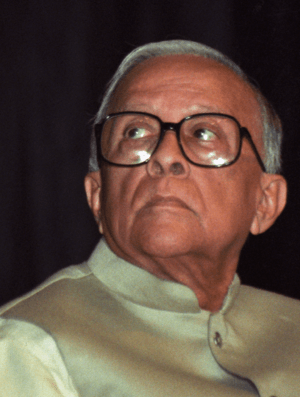Communist Party of India (Marxist) facts for kids
Quick facts for kids
Communist Party of India (Marxist)
|
|
|---|---|
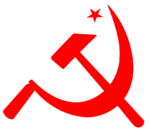 |
|
| Abbreviation | CPI(M), CPIM, CPM |
| Lok Sabha leader | K Radhakrishnan |
| Rajya Sabha leader | John Brittas |
| Founder |
List
P. Ramamurthi
M. Basavapunnaiah E. M. S. Namboodiripad H. S. Surjeet Promode Dasgupta Jyoti Basu H. K. Konar P. Sundarayya B. T. Ranadive A. K. Gopalan |
| Founded | 7 November 1964 |
| Split from | Communist Party of India |
| Headquarters | A. K. Gopalan Bhawan, 27–29, Bhai Vir Singh Marg, New Delhi-110 001 |
| Newspaper | People's Democracy Ganashakti Deshabhimani Theekkathir Loklahar Daily Desher Katha |
| Student wing |
|
| Youth wing |
|
| Women's wing | All India Democratic Women's Association |
| Labour wing | Centre of Indian Trade Unions |
| Peasant's wing |
|
| Membership | |
| Ideology | Communism Marxism-Leninism Secularism |
| Political position | Left-wing |
| International affiliation | IMCWP |
| Colours | Red |
| ECI Status | National Party |
| Alliance |
Alliances
|
| Seats in Lok Sabha |
4 / 543
|
| Seats in Rajya Sabha |
4 / 245
|
| Seats in State legislatures |
80 / 4,036
(Total)
State Legislatures
62 / 140
(Kerala)
10 / 60
(Tripura)
2 / 234
(Tamil Nadu)
2 / 243
(Bihar)
1 / 126
(Assam)
1 / 90
(Jammu & Kashmir)
1 / 147
(Odisha)
1 / 288
(Maharashtra) |
| Number of states and union territories in government |
3 / 31
|
| Election symbol | |
Hammer Sickle and Star |
|
| Party flag | |
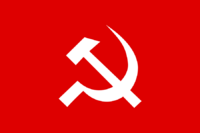 |
|
The Communist Party of India (Marxist), often called CPI(M), is a major communist political party in India. It is one of the six official national parties in the country. The party was formed in 1964 when it split from the Communist Party of India.
The CPI(M) is known for leading the Left Front government in West Bengal for 34 years. This was the longest-running, democratically elected communist government in the world.
Currently, the CPI(M) is part of the ruling government in the state of Kerala, where it leads the Left Democratic Front (LDF). It is also part of the ruling alliance in Tamil Nadu. The party has members in the legislative assemblies of seven different states.
The party's main decisions are made by its Central Committee. This committee elects a smaller group called the Politburo, which includes the General Secretary. The Politburo handles the party's work between Central Committee meetings.
Contents
How the Party Began
The CPI(M) was created from a split in the original Communist Party of India (CPI). After India's independence, the CPI became a powerful party. It even led armed struggles in places like Telangana and Kerala. However, the party later decided to work within India's democratic system instead of using armed revolution.
At the time, India had a close relationship with the Soviet Union, a large communist country. The Soviet government wanted Indian communists to support the ruling Indian National Congress party. However, many members of the CPI disagreed. They believed India still had major problems with inequality and that they should continue to fight for the rights of workers and poor people.
These disagreements grew stronger over time. One group, called the "right-wing," wanted to follow the Soviet Union's advice. The other group, the "left-wing," wanted the party to be independent and focus on India's specific problems. This "left-wing" group eventually formed the CPI(M) in 1964.
The Split in 1964
The split was also influenced by a major disagreement between the world's two largest communist powers: the Soviet Union and China. The members who formed the CPI(M) were often seen as being closer to China's ideas.
On April 11, 1964, 32 members walked out of a CPI National Council meeting. They later held their own convention in Tenali, Andhra Pradesh. There, they decided to hold a separate Party Congress in Kolkata.
This congress took place from October 31 to November 7, 1964. The group officially named itself the 'Communist Party of India (Marxist)' to show it was different from the original CPI. Puchalapalli Sundarayya was elected as the party's first general secretary.
History of the Party
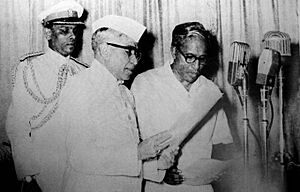
The CPI(M) faced many challenges in its early years. Many of its leaders and members were arrested. The party organized protests against rising prices and food shortages, especially in West Bengal.
In the 1967 elections, the CPI(M) did very well. It became a major party in West Bengal and Kerala. In Kerala, a government led by CPI(M) leader E. M. S. Namboodiripad was formed. In West Bengal, the party was the main force in a coalition government.
The Naxalbari Uprising
In 1967, a peasant revolt started in a village called Naxalbari in West Bengal. It was led by some radical members of the CPI(M), including Charu Majumdar. They believed in a more violent revolution, inspired by China's leader, Mao Zedong.
This event, known as the Naxalbari uprising, caused a major split within the CPI(M). The leaders of the uprising broke away and formed a new party, the Communist Party of India (Marxist-Leninist). The followers of this new party became known as Naxalites. This led to a period of conflict between the CPI(M) and the Naxalites.
The Emergency (1975–1977)
In 1975, Prime Minister Indira Gandhi declared a State of Emergency. During this time, elections were suspended and many civil rights were taken away. The CPI(M) was one of the main parties that opposed the Emergency. Many of its members were arrested, and others had to go into hiding.
The party supported the movement led by Jayaprakash Narayan to restore democracy. After the Emergency ended in 1977, the CPI(M) joined an alliance with the Janata Party for the general election, which they won.
The Party in State Governments
The CPI(M) has had its greatest success at the state level, forming governments in West Bengal, Kerala, and Tripura for many years.
West Bengal
In 1977, the Left Front, a coalition led by the CPI(M), won the state election in West Bengal. Jyoti Basu became the chief minister and served for 23 years, making him the longest-serving chief minister in India's history.
The Left Front ruled West Bengal for 34 years in a row, from 1977 to 2011. During this time, they introduced important reforms, especially Operation Barga, which gave land rights to poor farmers. After Jyoti Basu, Buddhadeb Bhattacharjee served as chief minister until 2011. The Left Front lost power in the 2011 election.
Kerala
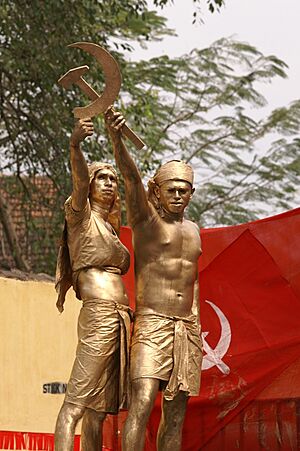
The CPI(M) has been a powerful force in Kerala's politics since the 1960s. The state's politics is dominated by two major alliances: the Left Democratic Front (LDF), led by the CPI(M), and the United Democratic Front (UDF), led by the Indian National Congress.
Power in Kerala has often switched between these two alliances. The LDF, led by the CPI(M), has formed the government many times. E. K. Nayanar was the longest-serving chief minister of Kerala. In 2021, the LDF government led by Pinarayi Vijayan was re-elected, a historic event in Kerala politics. Pinarayi Vijayan is the current chief minister.
Tripura
The CPI(M) also led the Left Front government in Tripura for many years. Nripen Chakraborty became the first CPI(M) chief minister of the state in 1977.
The Left Front ruled Tripura from 1978 to 1988 and again from 1993 to 2018. Manik Sarkar was the chief minister for 20 years, from 1998 to 2018, making him the state's longest-serving chief minister. Currently, the CPI(M) is the main opposition party in Tripura.
Party Leadership
The CPI(M) is guided by its leaders, who are chosen at the Party Congress, a large meeting held every few years.
General Secretaries
The General Secretary is the highest leader of the party. A person can be General Secretary for a maximum of three terms, but in special cases, a fourth term is possible.
- Puchalapalli Sundarayya (1964–1978): The first General Secretary.
- E. M. S. Namboodiripad (1978–1992): A former Chief Minister of Kerala.
- Harkishan Singh Surjeet (1992–2005): A key leader from Punjab.
- Prakash Karat (2005–2015): Led the party for a decade.
- Sitaram Yechury (2015–2024): Served until his death in 2024.
- M. A. Baby (2025–present): The current General Secretary, elected in 2025.
Politburo
The Politburo is the main leadership body that makes day-to-day decisions. As of 2025, it has 18 members, including key leaders from different states.
Main Groups and Organizations
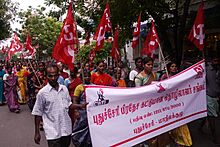
The CPI(M) has several organizations for different groups of people:
- Youth: Democratic Youth Federation of India (DYFI)
- Students: Students' Federation of India (SFI)
- Workers: Centre of Indian Trade Unions (CITU)
- Farmers: All India Kisan Sabha (AIKS)
- Women: All India Democratic Women's Association (AIDWA)
Election Performance
The CPI(M)'s performance in national elections has varied over the years.
The party had its best result in the 2004 general election, when it won 43 seats in the Lok Sabha (the lower house of India's Parliament). This made it the third-largest party in the country.
In recent elections, the party's number of seats has decreased. In the 2019 election, it won 3 seats. In the 2024 election, it won 4 seats. The party continues to have a strong presence in state politics, especially in Kerala.
Images for kids
-
CPI election campaign in Karol Bagh, Delhi, for the 1952 Indian general election
-
A. K. Gopalan (left), B. T. Ranadive (center), E.M.S. Namboodiripad (right) and H. K. Konar (far right) with other leaders in Kolkata, 1966.
-
E. M. S. Namboodiripad and J. S. Lyallpuri, 1966.
-
P. Sundarayya with the 1st President of Romania, Nicolae Ceaușescu, in 1969.
-
E. M. S. Namboodiripad with Romanian President Nicolae Ceaușescu, 1979.
-
H. S. Surjeet, Jyoti Basu, Lakshmi Sahgal, and Sitaram Yechury at the 18th party congress in Delhi, 2005.
-
A CPI(M) rally for its 18th Congress in Delhi.
See also
 In Spanish: Partido Comunista de la India (Marxista) para niños
In Spanish: Partido Comunista de la India (Marxista) para niños
- List of political parties in India
- List of communist parties in India
- Left Front (West Bengal)
- Left Democratic Front (Kerala)
- Left Front (Tripura)
- Politics of India


